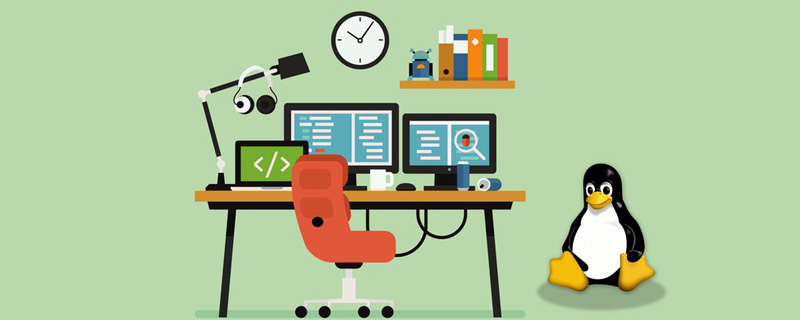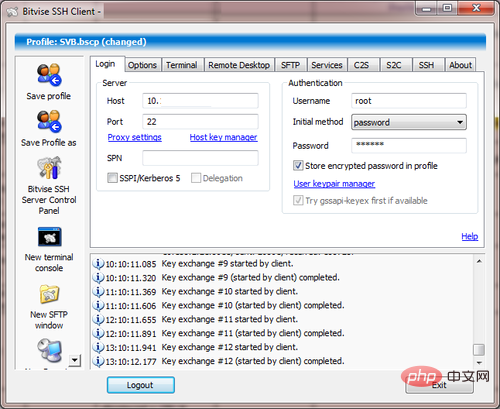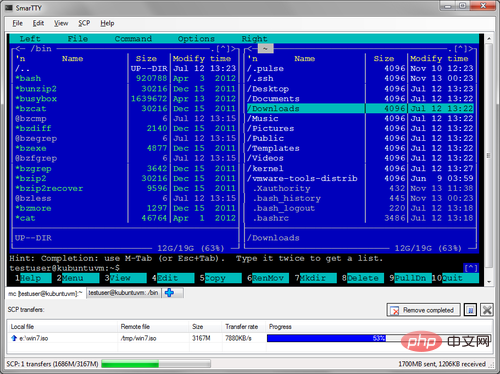What are the linux connection tools?
Generally, when we install Linux, it is basically used as a server, and basically the server only has one host, without a keyboard and monitor. How do we manage the server when we cannot access the physical machine? This article will introduce the commonly used tools for connecting to Linux that you come across at work.

1. putty
Putty is the most famous SSH and telnet client, developed by Simon Tatham for the Windows platform. Putty is an open source software that provides available source code and is developed and supported by a group of volunteers.

Putty is easy to install and use, and usually most configuration options do not need to be modified. Users only need to enter a few basic parameters to start a simple connection session.
2. Bitvise SSH Client
Bitvise SSH is a Windows client that supports SSH and SFTP. Developed and professionally supported by Bitvise. This software tool has outstanding performance, is easy to install and use. Bitvise SSH client has a feature-rich graphical interface and dynamic port forwarding through a built-in proxy with automatic reconnection function.

It is understood that the Bitvise SSH client is free for individual users and is also free for internal personal commercial use.
3. MobaXterm
MobaXterm is a toolbox for remote computing. In a single Windows application, MobaXterm provides programmers, webmasters, IT administrators and other users with a package of remote operation functions.

In addition, MobaXterm provides all important remote network tools (such as SSH, X11, RDP, VNC, FTP, MOSH, etc.), as well as Unix commands on the Windows desktop ( bash, ls, cat, sed, grep, awk, rsync, etc.), all provided as a single portable executable that works out of the box and is free for personal use.
4. DameWare SSH
DameWare SSH is a free SSH client. This free tool is a terminal emulator that can establish multiple telnet and SSH connections from one easy-to-use console.

Save frequently used sessions in the Windows file system
Use multiple sets of saved certificates to easily log in to different devices
Use Telnet, SSH1 and SSH2 protocols connect computers and devices
5. SmarTTY
SmarTTY is a free multi-label SSH client that supports copying files at any time using SCP commands and catalog.

The SSH server supports up to 10 sub-sessions per connection. What SmarTTY does: no multiple windows, no need to log in again, just open a new tab.
6. Cygwin
Cygwin is a collection of GNU and open source tools that provides functions similar to Linux under a Windows platform.
Cygwin includes a Unix system called a simulation library: cygwin.dll, which integrates a large number of GNU and other free software. In the installation package, there are high-quality compilers and other software development tools, an X11 server, a complete X11 development suite, GNU emacs editor, Tex and LaTeX, openSSH (client and server), in addition to All required to compile and use the PhysioToolkit software under Windows.
Through the above tool introduction, which SSH tool is worth trying, you can choose according to your needs and preferences. If there are other SSH tools listed, you can leave a message to add them.
For more related knowledge, please pay attention to PHP Chinese website! !
The above is the detailed content of What are the linux connection tools?. For more information, please follow other related articles on the PHP Chinese website!

Hot AI Tools

Undresser.AI Undress
AI-powered app for creating realistic nude photos

AI Clothes Remover
Online AI tool for removing clothes from photos.

Undress AI Tool
Undress images for free

Clothoff.io
AI clothes remover

AI Hentai Generator
Generate AI Hentai for free.

Hot Article

Hot Tools

Notepad++7.3.1
Easy-to-use and free code editor

SublimeText3 Chinese version
Chinese version, very easy to use

Zend Studio 13.0.1
Powerful PHP integrated development environment

Dreamweaver CS6
Visual web development tools

SublimeText3 Mac version
God-level code editing software (SublimeText3)

Hot Topics
 1378
1378
 52
52
 What is Linux actually good for?
Apr 12, 2025 am 12:20 AM
What is Linux actually good for?
Apr 12, 2025 am 12:20 AM
Linux is suitable for servers, development environments, and embedded systems. 1. As a server operating system, Linux is stable and efficient, and is often used to deploy high-concurrency applications. 2. As a development environment, Linux provides efficient command line tools and package management systems to improve development efficiency. 3. In embedded systems, Linux is lightweight and customizable, suitable for environments with limited resources.
 Using Docker with Linux: A Comprehensive Guide
Apr 12, 2025 am 12:07 AM
Using Docker with Linux: A Comprehensive Guide
Apr 12, 2025 am 12:07 AM
Using Docker on Linux can improve development and deployment efficiency. 1. Install Docker: Use scripts to install Docker on Ubuntu. 2. Verify the installation: Run sudodockerrunhello-world. 3. Basic usage: Create an Nginx container dockerrun-namemy-nginx-p8080:80-dnginx. 4. Advanced usage: Create a custom image, build and run using Dockerfile. 5. Optimization and Best Practices: Follow best practices for writing Dockerfiles using multi-stage builds and DockerCompose.
 How to start apache
Apr 13, 2025 pm 01:06 PM
How to start apache
Apr 13, 2025 pm 01:06 PM
The steps to start Apache are as follows: Install Apache (command: sudo apt-get install apache2 or download it from the official website) Start Apache (Linux: sudo systemctl start apache2; Windows: Right-click the "Apache2.4" service and select "Start") Check whether it has been started (Linux: sudo systemctl status apache2; Windows: Check the status of the "Apache2.4" service in the service manager) Enable boot automatically (optional, Linux: sudo systemctl
 What to do if the apache80 port is occupied
Apr 13, 2025 pm 01:24 PM
What to do if the apache80 port is occupied
Apr 13, 2025 pm 01:24 PM
When the Apache 80 port is occupied, the solution is as follows: find out the process that occupies the port and close it. Check the firewall settings to make sure Apache is not blocked. If the above method does not work, please reconfigure Apache to use a different port. Restart the Apache service.
 How to monitor Nginx SSL performance on Debian
Apr 12, 2025 pm 10:18 PM
How to monitor Nginx SSL performance on Debian
Apr 12, 2025 pm 10:18 PM
This article describes how to effectively monitor the SSL performance of Nginx servers on Debian systems. We will use NginxExporter to export Nginx status data to Prometheus and then visually display it through Grafana. Step 1: Configuring Nginx First, we need to enable the stub_status module in the Nginx configuration file to obtain the status information of Nginx. Add the following snippet in your Nginx configuration file (usually located in /etc/nginx/nginx.conf or its include file): location/nginx_status{stub_status
 How to start monitoring of oracle
Apr 12, 2025 am 06:00 AM
How to start monitoring of oracle
Apr 12, 2025 am 06:00 AM
The steps to start an Oracle listener are as follows: Check the listener status (using the lsnrctl status command) For Windows, start the "TNS Listener" service in Oracle Services Manager For Linux and Unix, use the lsnrctl start command to start the listener run the lsnrctl status command to verify that the listener is started
 How to set up a recycling bin in Debian system
Apr 12, 2025 pm 10:51 PM
How to set up a recycling bin in Debian system
Apr 12, 2025 pm 10:51 PM
This article introduces two methods of configuring a recycling bin in a Debian system: a graphical interface and a command line. Method 1: Use the Nautilus graphical interface to open the file manager: Find and start the Nautilus file manager (usually called "File") in the desktop or application menu. Find the Recycle Bin: Look for the Recycle Bin folder in the left navigation bar. If it is not found, try clicking "Other Location" or "Computer" to search. Configure Recycle Bin properties: Right-click "Recycle Bin" and select "Properties". In the Properties window, you can adjust the following settings: Maximum Size: Limit the disk space available in the Recycle Bin. Retention time: Set the preservation before the file is automatically deleted in the recycling bin
 How to optimize the performance of debian readdir
Apr 13, 2025 am 08:48 AM
How to optimize the performance of debian readdir
Apr 13, 2025 am 08:48 AM
In Debian systems, readdir system calls are used to read directory contents. If its performance is not good, try the following optimization strategy: Simplify the number of directory files: Split large directories into multiple small directories as much as possible, reducing the number of items processed per readdir call. Enable directory content caching: build a cache mechanism, update the cache regularly or when directory content changes, and reduce frequent calls to readdir. Memory caches (such as Memcached or Redis) or local caches (such as files or databases) can be considered. Adopt efficient data structure: If you implement directory traversal by yourself, select more efficient data structures (such as hash tables instead of linear search) to store and access directory information





